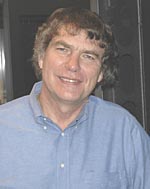Awards and Honors
UCSC astrophysicist Stan Woosley awarded
the American Physical Society's 2005 Hans A. Bethe Prize
By Tim Stephens
The American Physical Society has awarded the 2005 Hans A.
Bethe Prize to Stan Woosley, professor of astronomy and astrophysics
at UCSC. The Bethe Prize was established to recognize outstanding
work in the areas of astrophysics, nuclear physics, and related
fields.

Stan Woosley
Tim Stephens photo
|
Woosley, an expert in theoretical high-energy astrophysics,
studies the most violent explosions in the universe--supernovae
(the massive explosions of dying stars) and gamma ray bursts
(mysterious blasts of intense radiation). He has developed some
of the most sophisticated computer simulations of supernova
explosions and gamma-ray bursts, and his "collapsar"
model of gamma-ray bursts is the leading theory explaining how
they occur.
The Bethe Prize recognizes Woosley "for his significant
and wide-ranging contributions in the areas of stellar evolution,
element synthesis, the theory of core collapse and type Ia supernovae,
and the interpretation of gamma-ray bursts--most notably, the
collapsar model of gamma-ray bursts." The prize, consisting
of $7,500 and a certificate, will be presented at the American
Physical Society meeting in Tampa, Florida, in April 2005.
Woosley's work on the evolution of massive stars, which sets
the stage for supernova explosions, helps explain how elements
like oxygen and iron are formed. A supernova occurs when the
core of a star collapses under the gravitational force of its
own mass. The resulting explosion can be as bright as an entire
galaxy, releasing immense amounts of energy. The explosion also
spews into space all of the chemical elements forged by nuclear
fusion reactions during the life of the star and some that are
formed during the explosion itself. These materials may then
contribute to the formation of new stars and planets.
According to Woosley's collapsar model, gamma-ray bursts arise
from the collapse of stars that are too massive to successfully
explode as supernovae.
Woosley is director of the Center for Supernova Research, funded
by the Department of Energy and headquartered at UCSC. He is
a co-investigator on the HETE-2 satellite, launched in 2002
to study gamma-ray bursts, and is involved in planning NASA's
other missions for gamma-ray astronomy.
Hans A. Bethe won the Nobel Prize in physics in 1967 for his
description of the nuclear processes that power the sun. The
previous winner of the Bethe Prize is a UCSC alumnus, Wick Haxton
of the University of Washington, who earned his B.A. in physics
and mathematics at UCSC in 1971. For Woosley, the Bethe Prize
is the second honor connected with this great physicist. In
2002, he was the Hans A. Bethe Distinguished Lecturer at Cornell
University, where Bethe was a faculty member.
Woosley earned his B.A. in physics and M.S. and Ph.D. in astrophysics
from Rice University. He joined the UCSC faculty in 1975 and
has served three times as chair of the Department of Astronomy
and Astrophysics. The Division of Physical and Biological Sciences
honored him last year with its Outstanding Faculty Award for
2003-04. In 2001, Woosley was elected to the American Academy
of Arts and Sciences. He was elected a fellow of the American
Physical Society in 1987.
Return to Front Page